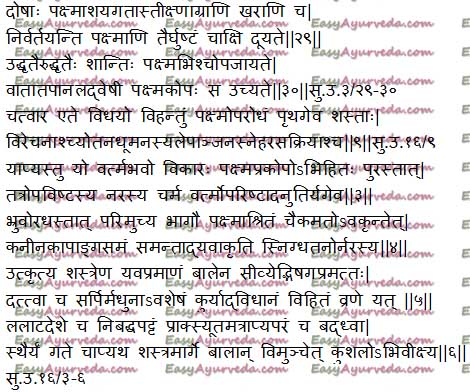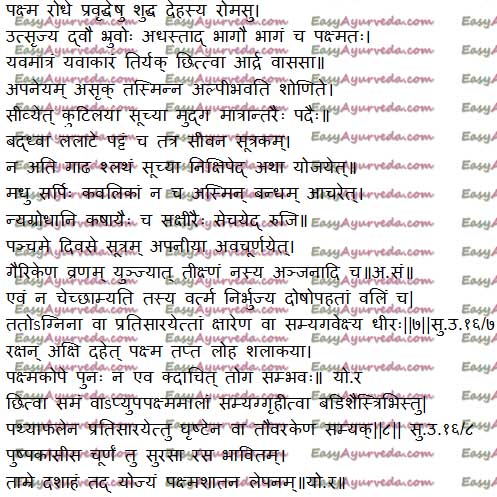Pakshmakopa (Trichiasis) Eye Disorder – Definition, Symptoms, Treatment
By Dr Raghuram Y.S. MD (Ay) & Dr Manasa, B.A.M.S
Pakshmakopa is one of the diseases of the eyelids (netra vartma gata roga).
Table of Contents
Introduction
Pakshma = eyelashes,
Kopa = aggravation, trouble causing
Pakshmakopa is a disorder of eyelashes and eyelids, with Dosha vitiation. It is correlated with Trichiasis.
Read – Eyelash Falling Out (Madarosis) – Ayurvedic Treatment And Therapies
Classification
Classification based on the location – Pakshmakopa is a Vartmagata Roga (disease occurring in the eyelids).
Classification based on Predominant Dosha – Pakshmakopa is a Tridoshaja Netra Roga i.e. it is caused by simultaneous vitiation of all the three doshas.
Classification based on Sadhya Asadhyata (prognosis) – Pakshmakopa is a yapya roga i.e. manageable disease. It can neither be cured completely nor is it incurable. It needs regular interventions to keep it away from recurring.
Classification based on predominant treatment / surgical process used in combating the disease – Pakshmakopa eye disorder as already said is a manageable disorder. As and when the eyelashes become troublesome they need to be removed.
Read – Classification of Eye Diseases As Per Ayurveda
Pakshmakopa, definition, meaning, pathogenesis
Pakshmakopa is an eye disorder and occurs in the eyelids. The disorder is named on the basis of the disturbed eyelashes going troublesome to the eyes. In this condition the doshas which have undergone vitiation get lodged in the abode of eyelashes i.e. eyelids and pockets in which they are rooted.
The disturbed eyelashes become pointed like pin and rough. The eyelids also turn backwards towards the eyeball such that the crooked eyelashes point towards the eyeball. The eyelashes which have turned inward along with the eyelid will cause friction over the eyeball and cause pain therein.
Read – Eye Diseases Causes, Pathogenesis, Symptoms, Treatment, Herbs
In this disorder one can find solace only after removing the eyelashes repeatedly, for many times. The person in this disorder becomes intolerant when his eyes are exposed to wind, sunlight or fire. Since this condition looks as if the eyelashes have got aggravated and are causing trouble to the eyeball, it is called Pakshmakopa eye disorder. Some other authors also call it by the name ‘Upapakshma’.
This condition is caused due to the simultaneous vitiation of all three doshas and is said to be manageable i.e. needs repeated intervention.
Read – Blepharitis: Inflamed Eyelids Ayurvedic Treatment, Remedies
Signs and Symptoms of Pakshmakopa
- Pakshmani teekshnagrani kharani cha – The eyelashes become pointed and rough in nature
- Nirvartayanti pakshmaani – the eyelashes become directed inwards towards the eyeball
- Tairghushtam cha akshi dooyate – the inward directed eyelashes rub and cause friction over the eyeball, as a result there is pain in the eye.
- Udhrutaih udhrutaih shaantih pakshmaabhascha upajaayate – the person finds comfort as and when the misdirected eyelashes are removed repeatedly
- Vata atapa anala dweshi – the eye becomes intolerant when it gets exposed to the wind, sunlight and fire
Read – Watery Eyes: Causes, Ayurvedic Treatment, Remedies
Modern correlation
Pakshmakopa eyelid disorder can be closely compared to one or more of the below mentioned conditions explained in modern medicine –
Trichiasis – is a condition in which there is in-growth or introversion of the eyelashes.
Distichiasis – is a rare disorder in which there is abnormal growth of eyelashes from the orifices of the meibomian glands on the posterior lamella of the tarsal plate. Here it looks like there is more than one row of eyelashes. Distichiasis is also called as ‘double row of eyelashes’.
Entropion – is a condition in which the eyelids, usually the lower eyelid folds inwards. The eyelashes consequentially rub against the cornea causing irritation.
Read – Vartmakardama, Shyavavartma Eye Disorders – Symptoms, Treatment
All the above mentioned conditions seem to represent Pakshmakopa eyelid disorder.

Pakshmakopa Chikitsa – Treatment modalities for misdirected eyelashes (Trichiasis, Distichiasis, Entropion)
Pakshmakopa is a manageable disorder. This means to tell that it needs continuous and repeated intervention in the form of removal of misdirected eyelashes and suitable medicinal approach. It also means that this disorder is not incurable.
Read – Stye – Causes, Symptoms, Remedies, Treatment
Master Sushruta has mentioned 4 fold treatment lineup for treatment of Pakshmakopa eye disorder. They are –
- Bheshaja – use of medicines
- Shastra karma – surgical interventions
- Kshara karma – application of alkali / cauterization using alkalis
- Agni karma – fire cauterization
Read – Ayurveda Eye Treatment Types, Methods – Ashtanga Hrudaya Sutrasthana 23
Apart from these, the below mentioned measures too should be adopted in effectively treating this disorder –
- Virechana – administration of purgation
- Aschotana – instillation of herbal eye drops
- Dhuma – administration of medicated smoking
- Nasya – administration of nasal medication / errhines
- Lepa – anointments / application of medicinal pastes
- Snigdha anjana – collyriums using fats or medicated fats
- Rasakriya – solidified decoctions
Read – Anjana – Collyrium Types, Method, Uses, Side Effects, Contra Indications
All these measures need not be used at a time. They can be skillfully chosen as and when required, as per the need and condition of the disease. Each treatment strategy has its individual importance in the treatment of pakshmakopa.
Some treatments can be intellectually combined for effective cure. Since pakshmakopa is yapya i.e. manageable, but not treatable in its totality, these treatments need to be repeated, as and when the condition recurs. Some medicines need to be used to prevent recurrence.
Read – Triphala Home Remedy For Eye Care
Surgical intervention in Pakshmakopa (Ref – Sushruta Uttara Ch 6)
Pre-operative procedures – The person who is to be treated with surgery shall be first administered with snehapana i.e. drinking of medicated fats. Once the person gets saturated with the fats, he should be made to sit straight on a chair. He should be advised to keep his eyes closed. Alternatively he should be made to sleep on a cot with his eyes closed.
Operative procedure –
- The area of the eyelid in between the eyebrow and the eyelashes (eyelid margin) should be divided into three equal parts.
- An incision is made leaving two portions below the eyebrow and one portion above the eyelashes, i.e. at the junction of these two portions, equidistance from the inner and outer angle (canthus) of the eye.
- Later an excision should be made obliquely, all through, in the shape and size of the corn of barley.
- This excision should be done with the help of a sharp instrument.
- The margins of the lesion shall be stitched with the hair of horse.
- The part should later be treated with ghee and honey.
Read – Chaturvidha Netra Srava – 4 types of eye discharges, symptoms, treatment
Post-operative procedures – The two ends of the sutures should be fixed over the forehead with the help of a bandage. After confirming that the two ends which were sutured have been properly united and that the lid has become stable, the physician should remove the stitches made with horse hair.
Read – Computer Vision Syndrome: Causes, Ayurvedic Remedies, Tips
Surgical method explained by Master Vagbhata
- Shodhana – initially the patient should be given with cleansing treatment using Panchakarma methods as per requirement.
- Yavakruti Chedana – the patient should be made to sit with closed eyes and excision of the shape and size of barley corn should be done over the afflicted lid, in the region of misdirected lashes.
- Asruk apanayana – the blood coming out of the excised area of the eyelid should be wiped off using a damp cloth.
- Seevana – after the bleeding has totally stopped, the physician should put sutures at distance of a green gram grain each. The hairs of horse shall be taken for suturing.
- Patta bandhana – a bandage should be done on the forehead. To this bandage the ends of the sutures should be stitched. Bandage should not be administered over the eyelids.
- Madhu sarpi kavalika – a gauze on which ghee and honey has been put should be kept on the region where sutures are applied.
- Sechana – if the person feels pain in the eyelids, the physician should gently pour streams of decoction prepared with the barks of Nyagrodha etc latex yielding trees mixed with milk and made warm.
- Sutram apaneyet – on the 5th day, the suture should be removed.
- Prakshepana – after removing the sutures, the powder of gairika i.e. red ochre should be dusted over the area.
Read – Sushruta’s 8 Types Of Surgical Procedures – Astavidha Shastra Karma
Alkali and Fire Cauterization therapies in Pakshmakopa Eye Disorder
If the Pakshmakopa eye disorder cannot be fixed through surgical measures, the physician should think of administering alkali or fire cauterization. For this, the lids should be reverted and physician should cauterize the site where there are misdirected lashes by applying alkali or fire.
Yogaratnakara treatise advises to use hot iron rod / needle to burn the site of misdirected lashes while protecting the eyes of the patient. The author also claims that once burnt, the hairs i.e. eyelashes wouldn’t grow back in that area.
Read – Kshara Agnikarma Vidhi – Cauterization- Astanga Hridaya Sutrasthana 30
Epilation and fire cauterization as explained by Mater Vagbhata
Master Vagbhata advises the physician to hold the excessively grown eyelashes with pakshma sandamsha instrument i.e. epilation forceps and removed. The roots of the eyelashes (socket in which the extra lashes were grown) should be burnt using hot red needles.
Excision of Upapakshma mala
If the Pakshmakopa eye disorder cannot be treated comprehensively by the above mentioned surgical, alkali or fire cauterization methods, one should resort to excision of the afflicted part.
Upapakshma mala means the extra row of eyelashes which are misdirected. The region of the eyelid wherein an extra row of eyelashes have grown should be properly held and gripped with the help of three hooks and excised.
Later, the fruit of Terminalia chebula or Hydnocarpus laurifolia should be rubbed with water and the resultant paste should be gently rubbed over the excised wound.
Read – Procedure of surgical operation: Ashtanga Hrudaya Sutrasthana 29
Churnanjana collyrium
Powder of Pushpa Kasisa i.e. yellow variety of ferrous sulfate should be triturated with juice of basil leaves and kept in copper vessel for 10 days. This should be used as collyrium in pakshmakopa eyelid disorder. This will make the extra grown eyelashes to fall off.

Modern treatment methods
Modern methods of treating Pakshmakopa (trichiasis, distichiasis or entropion)
1. Epilation of cilia – The eyelashes are held using epilation / cilia forceps and pulled out of their sockets. This need to be done as and when the lashes come out. We have seen that Ayurveda also has explained about epilation.
2. Electrolysis – is a method of removal of hair roots by application of heat using an electric current. This shall be done after thorough epilation of cilia. The agnikarma i.e. fire cauterization or burning the roots of the eyelashes using burnt needles explained in Ayurveda resemble with this method.
Read – Pothaki, Klishtavartma Eye Disorders – Symptoms, Treatment
3. Surgery – Many surgical methods are used to treat these conditions. They include –
- Snellens suture
- Gallardi’s suture
- Excision of horizontal strip of the skin (resembles with Master Sushruta’s surgical method)
- Hotz’s operation
- Panna’s operation for entropion
- Ewings operation for entropion
- Macheck blask Veize operation
- Van milligun technique
- Excision of the tarsus (resembles with the excision of upapakshma mala explained in Ayurveda)
- Galvano cautery punctures
Click to Consult Dr Raghuram Y.S. MD (Ayu) – Email / Skype







